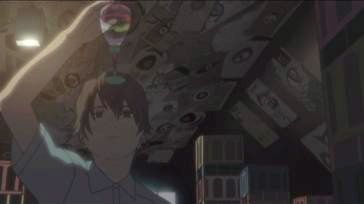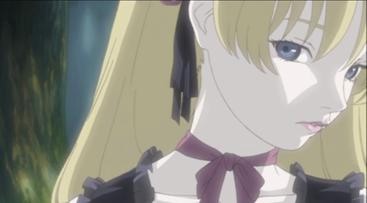|
"I met the spirit of a girl. And then, I somehow inherited both the soul and the destiny of the man who killed her. I believe I'm entering the realm of insanity, but I'm fine with that... because I fell in love with her, and this is what she wished for. But still..." |
|
Eiri |
One of 2004's standout animé OVAs, Le Portrait
de Petite Cossette, is released this week courtesy of
MVM. Cossette has a predominantly "Gothic Lolita"
style, which basically refers to one or more female character
wearing Victorian-style dresses with a modern "Gothic" look.
As a story, it's a gothic horror fantasy, with some minor
noir trappings, and features some disturbing and graphic
scenes and surreal imagery. It's based on the manga of the
same name by Asuka Katsura. This release contains all three
35-minute episodes.
Art
student Eiri works part-time at his grandfather's antiques
shop in a quiet corner of modern-day Tokyo. One day, his
grandfather sends his latest acquisition in – several items
of European furniture and glassware, one piece of which
is a beautiful Venetian goblet that shines in many colours
when held up to the light. Eiri soon begins to have visions
of a beautiful, blonde-haired girl – named Cossette – seemingly
trapped inside of the glass; he finds himself falling in
love with her. During a particularly powerful vision, Eiri
enters into a "blood pact" with her, and unwittingly takes
on the responsibility of atoning for the crimes of her murderer.
Only when she has been fully avenged, can her spirit leave
the glass.
Eiri
becomes trapped in a nightmare world of supernatural illusions.
Forced to suffer great pain in order to atone for her murder,
he nonetheless remains spellbound by her beauty and very
much in love with her. His love soon becomes an obsession
– Eiri takes to spending all his time at the antiques shop,
talking with her through the glass. His friends notice that
something's wrong, and are naturally concerned, but don't
know what to do about it. Meanwhile, Eiri becomes increasingly
tangled in the story of Cossette's life, and the mystery
surrounding her death... and her murderer.

It's
only in the third episode that the true message of the animé
is revealed. Not giving too much away, it's the great wisdom
that true beauty lies within, and that portraits can only
capture the superficial surface beauty of the subject. It
might be a cliché, but the tangled web that the story
weaves as it guides Eiri (and the viewer) through the nightmare
realm of Cossette's purgatory only serves to reinforce the
message until it's spelled out at the end of the series.
And even if you don't have much love for the genre, I guarantee
that you will be blown away – if not by the story, then
by what dresses it up.
Because
visually, Cossette is stunning. As you'd expect from a production
marketing itself as "Gothic Lolita", there's all the hallmarks
of the genre – Cossette wears long, flowing gowns and Victorian
costumes almost exclusively, and while the real-world setting
of Tokyo is drab, grey and nearly always raining, Eiri's
antiques shop is full of gothic atmosphere, with intricately-patterned
antiques and a multitude of ornate glasses and paintings.
Landscapes and environments in general are very well drawn
– shots of the real world seem almost like paintings, while
Cossette's world of surreal illusions is bursting with colour
and great environment design. The characters move very fluidly
– sometimes, I thought, aided by CGI. They're all very pale,
Cossette especially, but that's to be expected of the genre.
The production employs the overexposed lighting technique
that's almost becoming commonplace, but it works better
here than most of the contemporary animé that have
overused the style.
Music
is provided by Yuki Kajiura, who garnered critical acclaim
for her soundtrack to .hack//SIGN. Like her previous
work, Kajiura blends haunting and choral vocal performances
with European-styled instrumental pieces, and her closing
theme for the series is beautifully melodic. The style of
the individual pieces is ever-changing, and always complements
the scene it's used in. Fans of Kajiura's music will likely
be rushing to import the soundtrack album. The English dubbing
scores quite highly; the actors are well matched to their
characters, and – comparing some dialogue to the subtitling
– the content of the scenes has remained faithful to the
original language track.

Although
the influence of the gothic genre is ever-present, I have
no doubt that animé fans of most varieties will get
a kick out of Cossette. As with the horror-themed
Requiem from the Darkness, there is the occasional
"buckets of blood" scene – in several places, it gushes
forth a la Tarantino – so those of a sensitive disposition
might be put off, but overall I can wholeheartedly reccommend Cossette on the back of its artwork and music alone.
It's a rare visual treat that's not to be missed.
The
1.78:1 anamorphic transfer looks good, but the use of a
deliberately 'soft' animation style majkes it hard to judge
the detail level. Colours appear fine.
The
choice of English 5.1, Japanese 5.1 and Japanese DTS are
on offer. The Japanese 5.1 and DTS tracks are almost identical,
although some of the sound effects are a little louder on
the DTS track. The voices on the English dub are noticeably
louder and less well integrated than on the Japanese track.
A
Behind the Scenes featurette kicks off an
ok mix of features for this disc; a twenty-minute documentary
piece that interviews various people involved in the production,
from the director to the Japanese voice cast.
A
music video of the ending theme, "Jewel",
is presented next. Shot mostly in black and white, and in
traditional gothic style, it features the vocal talent of
Marina Inoue – who is also Cossette's voice actress.
Also
featured are the trailers for Cossette
itself – both the Japanese and US-produced versions – the
Japanese TV spot for the DVD release, and more trailers
for Requiem from the Darkness (appropriately), and
Tenjho Tenge (less appropriate).
|